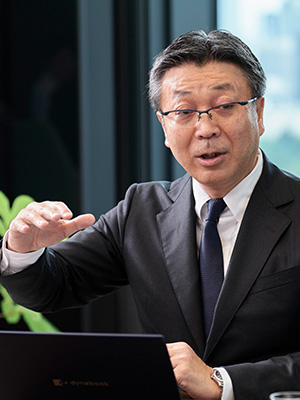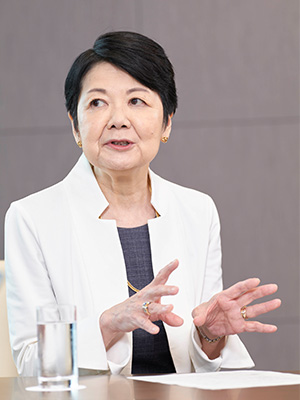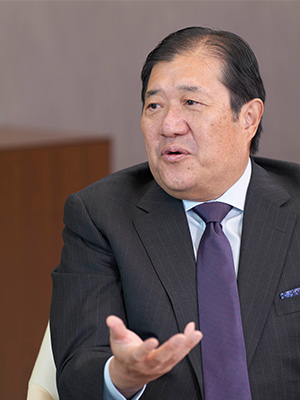Roundtable Discussion

Changes to Mitsui’s Governance Structure and Aiming for Further Improvement
Characteristics of Our Governance Structure
- Takano:First, please tell us about the characteristics of Mitsui’s governance structure.
- Egawa:I believe Mitsui’s Board of Directors has four characteristics. The first is that, as a company with an Audit & Supervisory Board, the Board of Directors is responsible for both important decisionmaking and oversight. Executive Committee members participate in discussions either as Internal Directors or observers, leading to substantive decision-making based on internal insights. Also, all of our decisions are made based on unanimous approval. The second point is the presence of Audit & Supervisory Board Members. Audit & Supervisory Board Members at Japanese companies are polarized into those who actively express their opinions and those who restrain their opinions. At Mitsui, Audit & Supervisory Board Members actively participate in discussions, enhancing the validity of decision-making. The third point is that decisions are made based on free and open-minded discussions, and management highly value the opinions of External Directors. The fourth point is that our External Directors are a highly diverse group of professionals, improving the quality of decision-making.
The diversity of the board is an important element that investors and other stakeholders pay close attention to. When appointing non-Japanese as directors, many Japanese companies choose those living in Japan. However, it is important that the Company went through various considerations before arriving at the current board composition in order to achieve true diversity of the Board of Directors. - Yasunaga:Non-Japanese living in Japan are well-versed in Japanese culture and therefore discussions may go rather smoothly. However, such discussions based on shared tacit understanding sometimes do not contribute to diversity in the true sense. People who are not familiar with Japanese culture often provide stimulating inputs and unexpected insights, and I believe that is the real value of diversity.
At Mitsui, engaging in global and cross-industry businesses, we are always wary that discussions based only on Japanese values could lead to future risks and missed opportunities. As such, welcoming non-Japanese with diverse values and expertise, those who have headed non-Japanese companies, or those who have led Japanese subsidiaries of non-Japanese companies, is a minimum requirement for Mitsui to be a global company. - Egawa:I totally agree. By having such diverse people on the Board, we can gain industry-specific expertise. It is also beneficial because they are familiar with the governance practices of companies outside Japan. For instance, we can hear opinions regarding the relationship between External Directors and executive management based on various examples.
- Takano:How do you evaluate voluntarily established committees at Mitsui, especially the Governance Committee?
- Egawa:Establishing the Governance, Nomination, and Remuneration Committees in 2004 was a progressive move at the time, and even now, few companies have a governance committee. Normally, the board of directors would discuss effectiveness of the board and institutional design, but having a governance committee allows more focused discussions on those issues. We have established the Governance Committee precisely because we recognize the importance of those discussions, and I believe its significance is understood by external stakeholders as well.
Changes to the Governance Structure
- Takano:Regarding the recent changes made to Mitsui’s governance structure, while the current organizational design of a company with an Audit & Supervisory Board remains unchanged, the number of Internal Directors was reduced from nine to six, which makes the ratio of External to Internal Directors equal at 6:6. The executive structure was also revised, which includes reaffirming the role of the Executive Committee members as the leadership team and establishing the position of General Counsel. Ms. Egawa, how do you evaluate this change?
- Egawa:I think it is a good change. Previously, the number of Directors was large and the ratio of Internal Directors was somewhat high, but we resolved those issues. In terms of the structure, we have now clearly distinguished between Directors, who are responsible for oversight, and the leadership team, with only Chief Officers of the leadership team becoming members of the Board of Directors. This has clarified the division of roles. Furthermore, although some of the officers in charge of business units are no longer Directors, they continue to attend Board meetings as observers, and this has resulted in a good structure that aligns with our strengths.
- Yasunaga:Looking back, when I became CEO in 2015, there were five External Directors, but we had more members with backgrounds in the public sector and academia rather than those with corporate management experience. Back then, we used to discuss issues from a company-wide perspective at Corporate Management Committee (currently the Executive Committee) meetings and strived to include the insights of External Directors at Board meetings, but I felt the need for even more diverse members on the Board to reflect more global views and broader corporate management insights.

- To discuss the overall management of the Company, it is necessary for the Board to deeply understand how our approach to HR and organizational management, as well as regional and business axes function, how we have reached the current earnings structure, and how all of these will lead to future developments for our business, through discussions on individual projects. Accordingly, we thought we should not compromise on ensuring the diversity of Directors’ backgrounds, and made gradual changes to the composition of the Board of Directors. The current six External Directors are truly diverse in terms of nationality, gender, careers, and views. I believe that the current Board formation is in many ways an ideal one. The Board is capable of not only deliberating each investment, but also engaging in more profound discussions, while considering the background to each investment.
At that point I thought the Board moved closer to its ideal form, but it has been pointed out that Board meetings need to be more interactive and that discussions sometimes had become like Q&A sessions between Internal and External Directors. It had also been suggested that the Board should not just deliberate on individual investments but should also delve deeper into more overarching, important matters that could define the Company’s future, which I thought was indeed a valid point.
Currently, the Board of Directors actively discusses various themes from a higher perspective, such as how the Company can allocate its resources in order to sustainably grow in the future and position itself to contribute to society. - Egawa:Thanks to your explanation, I now understand the transition of Mitsui’s Board of Directors.
In recent years, many Japanese companies have raised the ratio of external directors, so I thought it would be good for Mitsui to slightly increase that ratio as well. Upon official approval at the most recent General Meeting of Shareholders, the ratio of External Directors reached 50%. - Takano:Was there any particular discussion that impressed you?
- Egawa:What impressed me most was the positioning of Internal Directors. It was what we spent the most time discussing, and I believe it was essentially one of the most important topics. To thoroughly deliberate individual investments within the Board, the insights of Internal Directors are indispensable, and there were also concerns whether engaging with external parties without the director title could be disadvantageous. I imagine that there were extended discussions within the Company, encompassing more than what we discussed in Board meetings or Governance Committee meetings. After considering those concerns and factors, we were able to organize the Board of Directors as a supervisory function with officers with CXO titles joining the Board, while the leadership team, as members of the Executive Committee, will emphasize its significance externally. As a result, the division of roles between oversight and execution became even clearer, and I believe that the increase in the ratio of External Directors has led to stronger oversight.
- Yasunaga:The Governance Committee discussed from scratch what governance should look like in its ideal form. We asked ourselves whether the authority of the officers in charge of business units would be reduced if they were no longer Directors, or whether it simply represents the changes in their expected roles. Eventually, we came to the conclusion that, by highlighting their roles as members of the Executive Committee?the leadership team?and by clearly contrasting the different roles played by the director and the executive side, we can ensure that they will function effectively under the new governance structure.
After extensive and detailed discussions and referring to the board composition of companies outside Japan, we ultimately made a decision on the current structure. At companies outside Japan, in terms of board members from the executive side, often, it is the CEO only, or the CEO and CFO at most, while the rest are external directors, and business execution is usually entrusted to the leadership team, such as the management committee or other forms of the executive decision-making body. Telling people from outside Japan that this restructuring has brought us up to international standards, the response is that there are still too many internal directors. On the other hand, the perception in Japan is that we are quite progressive.
We have communicated to the officers in charge of business units that not only will their authority be maintained, but more of a company-wide perspective will be required going forward. We also emphasize within the Company that this change has set us on the path to becoming an even more genuinely global company.
Furthermore, since we have such a diverse group of six External Directors, we thought it would be better to increase the role expectations and responsibilities of the External Directors, not as six out of 15, but as six out of 12. In that sense as well, each of the 12 members feels the weight of their respective opinions in steering the Company.
Recent Changes to Board Meetings
- Takano:Over the past few years, we have taken various steps to improve the effectiveness of the Board of Directors through changes to the way meetings are operated. For example, we have revised the criteria for matters to be resolved and introduced more thorough pre-meeting briefings for External Directors and External Members meetings. Other changes include providing more detailed information to External Directors. Ms. Egawa, what has been your impression of these initiatives?
- Egawa:The Company has been working for some time to revise its criteria for matters to be resolved by the Board of Directors so that the Board could focus on a smaller number of substantial items. In parallel with these efforts, we also discussed a reduction in the frequency of Board meetings. Board members residing outside Japan were especially vocal about that change. In fact, many non-Japanese companies have fewer board meetings and allocate more time to each meeting.
According to a survey that I referenced previously, American companies hold a total of five to nine board meetings per year, including four to five face-to-face meetings and one to four telephone meetings. The average duration of meetings was over five hours for face-to-face meetings and one hour for telephone meetings. My impression is that Mitsui’s practice is getting closer to those of overseas companies. Having reduced the frequency of meetings, we now use online meetings and written resolutions for urgent matters. Meanwhile, for our face-to-face meetings, we spend greater time on more substantive discussions. In addition to thorough pre-meeting briefings, we also hold free discussion sessions and the External Members Meeting before and after Board meetings. By combining sessions such as these, we have, in effect, increased the amount of discussion. The pre-meeting briefings also include explanations and discussions about investments that are strategically important but not included in the agenda for Board meetings. - Yasunaga:I also felt that we were holding too many Board meetings. However, when discussing investments, we also need to align our schedules with those of other parties, including our business partners and host countries. In some cases, it is too late if we only deliberate on investments once every three months. That is why we needed to hold meetings often enough to align with the speed of deal making. Under these circumstances, we have to adjust our approaches, such as discussing individual investments well in advance where possible or deliberating via online meetings. That said, some members have commented that it is difficult to discuss important projects online. So, while recognizing the need for in-person meetings, an ongoing issue for us is how to effectively modify the way in which meetings are conducted.

- Takano:What are your thoughts concerning changes in the themes discussed at Board meetings?
- Egawa:I see a number of significant changes. For example, in response to requests from External Directors, we now have more discussions on portfolio reviews and sustainability-related issues. In particular, we now engage in more thorough discussions about HSE (health, safety and environment) reports, especially safety.
- Takano:I served as a member of the Board of Directors Secretariat until last year. Based on the comments from External Directors that the Board should be discussing broader and more strategic matters, we increased the opportunities for the Board to deliberate on important management matters. We also strived to thoroughly explain the positioning of individual investments in the context of overall strategies as we discussed them.
- Egawa:I also find it extremely useful to be briefed on the strategies and activities of each business unit at the External Members Meeting and other meetings. While deliberations about individual investments will deepen our understanding about business units engaged in large-scale investment and financing projects, we tend to have few opportunities to get to know other business units. This issue is now covered through setting the agenda items for Board meetings or External Members Meetings.
Aiming for Further Improvements to Governance
- Takano:What kind of improvements do you think we need in order to further enhance governance?
- Egawa:I believe that the Board of Directors needs to debate strategies from a company-wide perspective and continually work to deepen portfolio reviews with an emphasis on ROIC. I also think that from the perspective of maintaining discipline, it would be useful to decide in advance at the time of final investment decisions (FIDs) of large-scale investments that the investment will be reviewed in, for example, two to three years. As already commented in Governance Committee meetings and during effectiveness evaluations of the Board, I think that there should be regular opportunities for discussion sessions among just the External Directors and External Audit & Supervisory Board Members.
- Yasunaga:I would like External Directors to continue holding these sessions and highlight aspects that may not be apparent to those of us within the Company.
Meanwhile, our frontline staff continuously apply PDCA cycles to projects, while both the Portfolio Management Committee and the Executive Committee monitor progress on the middle game* for every investment. If all of this information were reported to the Board of Directors, there would be too much to report, and the Board would not be able to function effectively. The Board therefore needs to focus mainly on new projects and projects with issues. We also need to ensure that PDCA cycles are applied efficiently. For example, there are projects with issues for which reports are submitted on a weekly basis, so the executive side may need to reconsider how internal reporting should be made in order to improve efficiency. On a different note, I think paying visits to frontline operations is the best way for External Directors to learn about our frontline efforts to create value and enhance return on investment. This year, for example, External Directors were invited to visit some of our frontline operations in North America, and we would like to arrange more visits to provide opportunities to observe our frontline operations in each region. - Takano: Finally, as Chair of the Board, what is your vision for the future of the Board of Directors in light of the recent changes in the governance structure?
- Yasunaga:I would like to take a natural approach. Despite changes in the number of Directors and the composition of the Board of Directors, we will continue to prioritize our goal of achieving unanimity. Diversity is meaningless if opposing views are suppressed through majority decision-making. For us to sustainably grow while embracing diversity, unanimous decision-making by a diverse Board of Directors is essential. If we were unable to reach unanimous decisions, that would indicate that certain problems do exist. I therefore do not intend to change our basic commitment to making unanimous decisions. In my view, even if a deadline is looming and we do not have much time left, we need to debate issues fully and explore a conclusion that satisfies all members. This is the greatest value of our diverse Board of Directors. To continue providing this value, we will strive to have more interactive discussions and deepen our mutual understanding toward further enhancing the effectiveness of the Board of Directors.
* The intermediate stages between the entry and exit points of investments, where the focus is on enhancing individual businesses and implementing turnarounds to improve earnings power.
